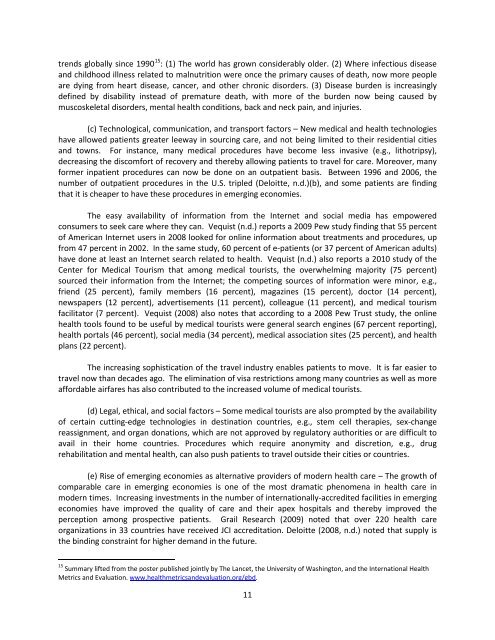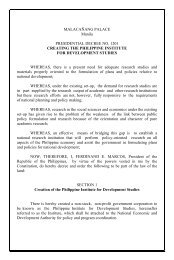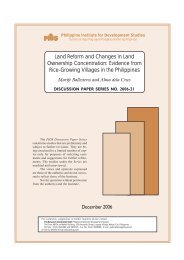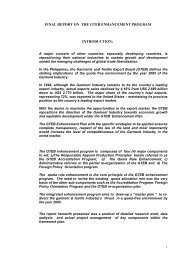abroad <strong>for</strong> an elective procedure if <strong>the</strong>y could save half <strong>the</strong> cost and assured quality was comparable.This figure is as high as 56.8 percent among Asian-Americans.Total economic sav<strong>in</strong>gs from medical tourism are significant. The 2008 study done by McK<strong>in</strong>seyestimated 710,000 procedures per<strong>for</strong>med outside <strong>the</strong> U.S. with an average sav<strong>in</strong>gs per procedure ofUS$15,000, which yielded US$10.7 billion total estimated sav<strong>in</strong>gs <strong>for</strong> patients, payors, and employers.Because of outsourc<strong>in</strong>g, <strong>the</strong> total loss <strong>for</strong> US hospitals was estimated to be US$35 billion. Becausesav<strong>in</strong>gs to <strong>the</strong> patients, payors, and employers translate to losses of U.S. hospitals, medical tourismwould have major political repercussions <strong>in</strong> <strong>the</strong> health sector of <strong>in</strong>dustrial countries.(b) Demographic and epidemiological factors – The ag<strong>in</strong>g population <strong>in</strong> <strong>in</strong>dustrial countries isfeed<strong>in</strong>g <strong>the</strong> growth of global medical tourism. The baby boomer generation has aged; <strong>in</strong> <strong>the</strong> U.S., <strong>the</strong>rewere 78 million people born between 1946 and 1964. By 2030, this population (age 66 to 84) will reach61 million and <strong>in</strong> that year, <strong>the</strong>re will be an estimated 9 million Americans born prior to 1946. By 2030,19 percent of <strong>the</strong> American population will be 65 years or older. The same ag<strong>in</strong>g trend is also occurr<strong>in</strong>g<strong>in</strong> Western Europe, Canada, Australia, and New Zealand (Wendt, 2012). This baby boomer populationwill require expensive medical treatment and care, much of which has become prohibitive <strong>in</strong> advancedcountries.Generations X and Y – those born <strong>in</strong> <strong>the</strong> latter 1960s and <strong>in</strong> <strong>the</strong> 1970s – have also gotten old.They are now <strong>in</strong> <strong>the</strong>ir 50s and 40s, and will reach retirement age <strong>in</strong> a decade or two. Thus, GenerationsX and Y will cont<strong>in</strong>ue to feed <strong>the</strong> grow<strong>in</strong>g medical tourist market well <strong>in</strong>to <strong>the</strong> next two decades.Indeed, some observers note that Generations X and Y may well dom<strong>in</strong>ate medical tourism market <strong>in</strong><strong>the</strong> next few years, ra<strong>the</strong>r than <strong>the</strong> baby boomer generation.Studies have confirmed <strong>the</strong> will<strong>in</strong>gness of <strong>the</strong>se American age cohorts to seek care abroad.Karuppan and Karuppan (2010) found that 81 percent of medical travelers were under <strong>the</strong> age of 50. In<strong>the</strong>ir survey, Keckley and Underwood (2009) found that 37 percent of baby boomers, 42 percent ofGeneration X, and 51 percent of Generation Y were will<strong>in</strong>g to undergo surgery abroad.Add to <strong>the</strong>se is a little known fact that more than half of <strong>the</strong> U.S. work<strong>for</strong>ce will be of second- orthird-generation <strong>for</strong>eign descent <strong>in</strong> <strong>the</strong> next 25 years (Deloitte, n.d.)(b). For <strong>for</strong>eign-descent residents <strong>in</strong><strong>the</strong> U.S. and Europe, homecom<strong>in</strong>g visits are often planned with elective or cosmetic surgeries. Filip<strong>in</strong>oresidents <strong>in</strong> <strong>the</strong> U.S. alone are estimated to number more than 2 million.The ag<strong>in</strong>g population <strong>in</strong> Western countries also means <strong>in</strong>creas<strong>in</strong>g health-service supplyconstra<strong>in</strong>ts because of (a) large number of retir<strong>in</strong>g health workers, and (b) <strong>in</strong>creas<strong>in</strong>g number of healthworkers who are leav<strong>in</strong>g <strong>the</strong> health profession much earlier than expected. The U.S. is currentlyexperienc<strong>in</strong>g a severe doctor shortage, and one study <strong>in</strong> 2010 found that 14 percent of U.S. physicianswill retire <strong>in</strong> <strong>the</strong> next five years while 34 percent will do so <strong>in</strong> <strong>the</strong> next ten years (Wendt, 2012). TheAmerican Dental Association also expects a significant proportion of dentists to retire over <strong>the</strong> next 20years (Deloitte, n.d.)(b).The chang<strong>in</strong>g burden of disease <strong>in</strong> <strong>the</strong> world is also contribut<strong>in</strong>g to movements of peopleseek<strong>in</strong>g care, <strong>for</strong> <strong>in</strong>stance, from poorer countries to more advanced ones. Non-communicable diseases(NCDs) have rapidly risen globally, lead<strong>in</strong>g to greater hospitalization. The global burden of disease studyof 2010 published <strong>in</strong> The Lancet (Volume 380, December 2012) reveals three massive shifts <strong>in</strong> health10
trends globally s<strong>in</strong>ce 1990 15 : (1) The world has grown considerably older. (2) Where <strong>in</strong>fectious diseaseand childhood illness related to malnutrition were once <strong>the</strong> primary causes of death, now more peopleare dy<strong>in</strong>g from heart disease, cancer, and o<strong>the</strong>r chronic disorders. (3) Disease burden is <strong>in</strong>creas<strong>in</strong>glydef<strong>in</strong>ed by disability <strong>in</strong>stead of premature death, with more of <strong>the</strong> burden now be<strong>in</strong>g caused bymuscoskeletal disorders, mental health conditions, back and neck pa<strong>in</strong>, and <strong>in</strong>juries.(c) Technological, communication, and transport factors – New medical and health technologieshave allowed patients greater leeway <strong>in</strong> sourc<strong>in</strong>g care, and not be<strong>in</strong>g limited to <strong>the</strong>ir residential citiesand towns. For <strong>in</strong>stance, many medical procedures have become less <strong>in</strong>vasive (e.g., lithotripsy),decreas<strong>in</strong>g <strong>the</strong> discom<strong>for</strong>t of recovery and <strong>the</strong>reby allow<strong>in</strong>g patients to travel <strong>for</strong> care. Moreover, many<strong>for</strong>mer <strong>in</strong>patient procedures can now be done on an outpatient basis. Between 1996 and 2006, <strong>the</strong>number of outpatient procedures <strong>in</strong> <strong>the</strong> U.S. tripled (Deloitte, n.d.)(b), and some patients are f<strong>in</strong>d<strong>in</strong>gthat it is cheaper to have <strong>the</strong>se procedures <strong>in</strong> emerg<strong>in</strong>g economies.The easy availability of <strong>in</strong><strong>for</strong>mation from <strong>the</strong> Internet and social media has empoweredconsumers to seek care where <strong>the</strong>y can. Vequist (n.d.) reports a 2009 Pew study f<strong>in</strong>d<strong>in</strong>g that 55 percentof American Internet users <strong>in</strong> 2008 looked <strong>for</strong> onl<strong>in</strong>e <strong>in</strong><strong>for</strong>mation about treatments and procedures, upfrom 47 percent <strong>in</strong> 2002. In <strong>the</strong> same study, 60 percent of e-patients (or 37 percent of American adults)have done at least an Internet search related to health. Vequist (n.d.) also reports a 2010 study of <strong>the</strong>Center <strong>for</strong> <strong>Medical</strong> <strong>Tourism</strong> that among medical tourists, <strong>the</strong> overwhelm<strong>in</strong>g majority (75 percent)sourced <strong>the</strong>ir <strong>in</strong><strong>for</strong>mation from <strong>the</strong> Internet; <strong>the</strong> compet<strong>in</strong>g sources of <strong>in</strong><strong>for</strong>mation were m<strong>in</strong>or, e.g.,friend (25 percent), family members (16 percent), magaz<strong>in</strong>es (15 percent), doctor (14 percent),newspapers (12 percent), advertisements (11 percent), colleague (11 percent), and medical tourismfacilitator (7 percent). Vequist (2008) also notes that accord<strong>in</strong>g to a 2008 Pew Trust study, <strong>the</strong> onl<strong>in</strong>ehealth tools found to be useful by medical tourists were general search eng<strong>in</strong>es (67 percent report<strong>in</strong>g),health portals (46 percent), social media (34 percent), medical association sites (25 percent), and healthplans (22 percent).The <strong>in</strong>creas<strong>in</strong>g sophistication of <strong>the</strong> travel <strong>in</strong>dustry enables patients to move. It is far easier totravel now than decades ago. The elim<strong>in</strong>ation of visa restrictions among many countries as well as moreaf<strong>for</strong>dable airfares has also contributed to <strong>the</strong> <strong>in</strong>creased volume of medical tourists.(d) Legal, ethical, and social factors – Some medical tourists are also prompted by <strong>the</strong> availabilityof certa<strong>in</strong> cutt<strong>in</strong>g-edge technologies <strong>in</strong> dest<strong>in</strong>ation countries, e.g., stem cell <strong>the</strong>rapies, sex-changereassignment, and organ donations, which are not approved by regulatory authorities or are difficult toavail <strong>in</strong> <strong>the</strong>ir home countries. Procedures which require anonymity and discretion, e.g., drugrehabilitation and mental health, can also push patients to travel outside <strong>the</strong>ir cities or countries.(e) Rise of emerg<strong>in</strong>g economies as alternative providers of modern health care – The growth ofcomparable care <strong>in</strong> emerg<strong>in</strong>g economies is one of <strong>the</strong> most dramatic phenomena <strong>in</strong> health care <strong>in</strong>modern times. Increas<strong>in</strong>g <strong>in</strong>vestments <strong>in</strong> <strong>the</strong> number of <strong>in</strong>ternationally-accredited facilities <strong>in</strong> emerg<strong>in</strong>geconomies have improved <strong>the</strong> quality of care and <strong>the</strong>ir apex hospitals and <strong>the</strong>reby improved <strong>the</strong>perception among prospective patients. Grail Research (2009) noted that over 220 health careorganizations <strong>in</strong> 33 countries have received JCI accreditation. Deloitte (2008, n.d.) noted that supply is<strong>the</strong> b<strong>in</strong>d<strong>in</strong>g constra<strong>in</strong>t <strong>for</strong> higher demand <strong>in</strong> <strong>the</strong> future.15 Summary lifted from <strong>the</strong> poster published jo<strong>in</strong>tly by The Lancet, <strong>the</strong> University of Wash<strong>in</strong>gton, and <strong>the</strong> International HealthMetrics and Evaluation. www.healthmetricsandevaluation.org/gbd.11
- Page 3: AbstractMedical Tourism in the Phil
- Page 6 and 7: Table of ContentsAbbreviations and
- Page 8 and 9: List of TablesTable 1. WTO’s Mode
- Page 11 and 12: c. Epidemiologically, the disease b
- Page 13 and 14: Revenue and Cost Trends of Selected
- Page 15 and 16: BenchmarksStatus10 Adoption of “h
- Page 17 and 18: S.W.O.T. Analysis of the Philippine
- Page 19 and 20: Chapter I. Background“Once your t
- Page 21 and 22: Chapter II. The Global Market for M
- Page 23 and 24: A major industry weakness is the ab
- Page 25 and 26: B. Demand, Revenues, and Market Opp
- Page 27: dermatology, 6.8 weeks; and cardiol
- Page 31: Table 5. Top 20 Medical Tourist Des
- Page 34 and 35: Chapter III. Philippine Medical Tou
- Page 36 and 37: f. HealthCORE’s (2011) estimate o
- Page 38 and 39: seek better health care, 15 percent
- Page 40 and 41: Cardinal Santos San Juan City P 197
- Page 42 and 43: sources, bone marrow and peripheral
- Page 44 and 45: found between siblings, but even th
- Page 46 and 47: Zen Institute (medicalspa)Bonifacio
- Page 48 and 49: control the dangers of poorly regul
- Page 50 and 51: American Eye CenterAsian Eye Instit
- Page 52 and 53: Medical andDental PracticesRate (ov
- Page 54 and 55: The benchmarking exercise did not b
- Page 56 and 57: d. Providence Hospital Inc., in Wes
- Page 58 and 59: Patients/Consumers”) with 41 year
- Page 60 and 61: Benchmark #14: Advancement in techn
- Page 62 and 63: society for Quality in Healthcare a
- Page 64 and 65: H. Travel and Accommodation Benchma
- Page 66 and 67: Figure 3. Price Variation Among Sel
- Page 68 and 69: Chapter VI. S.W.O.T. Analysis“Dev
- Page 70 and 71: insider noted, “You cannot play i
- Page 72 and 73: Continued high-cost care in advance
- Page 74 and 75: “medical complication” (Medical
- Page 76 and 77: Chapter VII. Conclusions and Next S
- Page 78 and 79:
ReferencesABS-CBN News (2013). Medi
- Page 80 and 81:
De la Cruz, Stef (2012). Is Stem Ce
- Page 82 and 83:
Marsek, P.W. and F. Sharpe (2009).
- Page 84 and 85:
Trade Daegu (2013). Daegu Global Me
- Page 86 and 87:
what have failed, and the means to
- Page 88:
Annex 3: Comments on the Draft Sena









